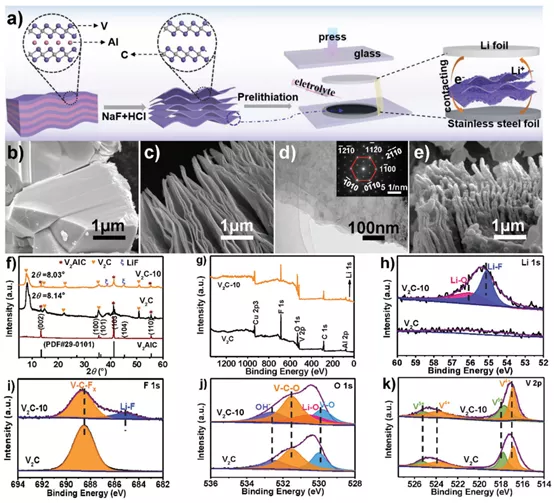Small: V-based MXene is used in magnesium-lithium hybrid batteries
QQ Academic Group: 1092348845
Detailed
¡¾Research Background¡¿
Lithium ion batteries (LIB) have attracted extensive attention and made great progress in the past few decades. However, LIB faces high prices, resource scarcity and security issues, so it is necessary to develop an alternative energy storage device. Rechargeable magnesium (Mg) batteries (RMB) are regarded as one of the promising "surpassing lithium-ion batteries", which is attributed to its several significant advantages, namely the divalent nature of Mg 2+ leads to high capacity (lithium 3833 vs 2062 mAhcm -3 ), the abundant magnesium resources in the earth¡®s crust and the dendrite-free nature of the magnesium metal anode make it safe to operate. Although magnesium has these potential advantages over lithium as a negative electrode material, the development of high-energy-density RMBS has been hindered by positive electrode materials and electrolytes. In order to solve this problem, one strategy is to design a hybrid battery that can use a double salt electrolyte to replace the kinetically slower Mg 2+ intercalation / embedding by a more kinetically efficient Li + or Na + diffusion part Out. In particular, this hybrid design can integrate the advantages of Mg metal negative electrode and Li + or Na + embedded positive electrode, thereby providing better safety, rate performance and cycle stability for the device. Recently, hybrid Mg 2+ / Li + ion batteries (MLIBs), as a new battery chemistry method, combine the high capacity, high voltage and rapid Li + insertion of lithium ion anodes with high capacity, low cost and no dendrites The negative electrode of Mg has caused great concern in the application of electrochemical energy storage.
¡¾Achievement Introduction¡¿
Recently, Fan Lizhen Beijing University of Technology professor research group in academic journals internationally renowned Small published an article entitled: Prelithiated V 2 C MXene: A High-Performance Hybrid Electrode for Magnesium / Lithium-the Ion Batteries by the Ion Cointercalation research paper, paper for the first time A low-cost, simple self-discharge method was developed to prepare pre-lithiated V 2 CMXene. This method can not only significantly increase the interlayer spacing and enrich the active sites of V 2 C nanosheets, but also compensate for the lithium ions consumed during the formation of the solid electrolyte interface (SEI) by providing an alternative lithium source. As expected, the LIB assembled using the pre-lithiated V 2 C negative electrode showed high reversible specific capacity, excellent initial coulombic efficiency (CE), cycle stability, and capacity retention. Even more impressive is that the pre-lithiated V 2 C achieved excellent electrochemical performance in MLIB. The potential reaction mechanism produced by reversible Mg 2+ / Li + ion co-intercalation was also elucidated by ex-situ X-ray diffraction (XRD) and X-ray photoelectron spectroscopy (XPS) .
¡¾Graphic introduction¡¿

Figure 1. a) Schematic diagram of the preparation process of V 2 CMXene and pre-lithiated V 2 C; b, c) SEM images of V 2 AlC and V 2 C, respectively ; d) TEM images of V 2 C, insets are SAED spectra ; E) SEM images of V 2 C after 10 minutes of pre-lithiation ; f) XRD patterns of V 2 AlC, V 2 C and V 2 C-10; g) XPS spectra of V 2 C and V 2 C-10, And the corresponding element hk) high-resolution XPS spectrum.

Figure 2. Lithium-ion battery performance

Figure 3. Performance of Mg / Li mixed ion battery

Figure 4. a) Ectopic XRD pattern of the V 2 C-10 electrode in the selected charge and discharge states during the first cycle . After the first discharge and charge, the ectopic XPS spectra of b) Mg 1s, c) Li 1s, d) F 1s, e) O 1s and f) V 2p of the V 2 C-10 electrode in MLIB .

Figure 5. a) Mg ion migration barrier on different V 2 CO 2 surfaces. b) Simulated migration path of Mg ions on the surface of V 2 CO 2 monolayer.
¡¾Summary of this article¡¿
In this paper, a simple and fast self-discharge method is used to prepare pre-lithiated V 2 C MXene with high ion storage capacity . Li + pre-intercalation can effectively reduce lithium consumption during the formation of SEI by providing an alternative lithium source, and expand the interlayer distance of MXene, thereby providing abundant active sites and fast ion transmission channels. When used as a negative electrode of LIB, it has a significant reversible capacity of 547.5 mA hg -1 at 0.05 A g -1 and a high initial CE of 80%, which can achieve a capacity retention rate of about 98% after 5000 cycles. As the positive electrode of MLIB, the co-intercalation of Mg 2+ and Li + contributes to an excellent reversible capacity of 230.3 mA hg -1 at 0.02 A g -1 , and a good cycle life, with 82% after 480 cycles Capacity retention rate. To date, there have been few reports of such excellent overall performance of such MXene-based LIB and MLIB electrodes. In addition, the ectopic XRD and ectopic XPS characterization verified the Mg / Li co-intercalation reaction mechanism. The discussion and research on battery chemistry opened up a new method for improving the initial CE of LIB electrodes, and clarified the application prospect of MXene-based materials as candidate materials for high-performance rechargeable MLIB electrodes.
Literature link:
https://doi.org/10.1002/smll.201906076
Source:
- Previous£º Lithiation-expansion-m
- Next£º IF 14.1! Tumor-derived


 mxene academic
mxene academic
